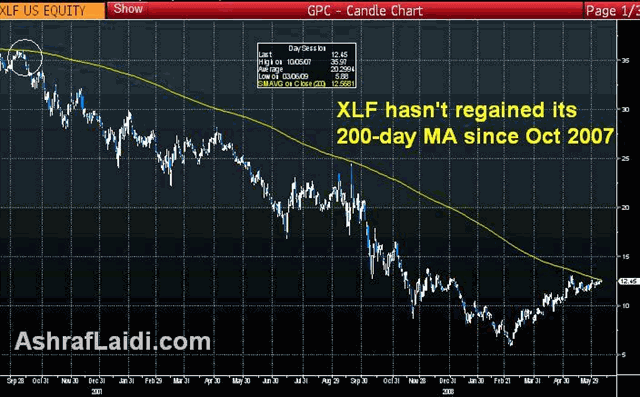Falling Equities Still Key for Dollar
The intermarket relationship underpinning the US currency and global equities remains largely unhinged, with falling equities persisting as the longe saviour for the corroding US dollar. And so once again the falling US dollar got a fresh respite from a falling stock market. Earlier in the day, the dollar seemed to succumb to one of those typical selling waves after better than expected UK housing numbers, improving confidence figures in Australia and higher than expected Norwegian inflation -- all of which bolstered the rally of these currencies against the greenback. Such figures reduce the need for quantitative easing in these economies, which only add to a widening in their yield differential ahead of the US currency. 
The dollar had seemed to take a fresh turn to the worst after starting to stabilize late last week into Tuesday due to: (i) retreating risk appetite once markets realized the veracity of those better then expected payrolls; (ii) remarks from Eurozone, Switzerland, Canada and New Zealand officials expressing concerns with the rapid rise in their currencies; (iii) political stress tests imposed on British pound following the Labour Partys resounding defeats in the European as well as the ensuing resignations; and (iv) S&Ps downgrade of Irelands credit rating.
The above dynamics proved to be mere profit-taking opportunities for dollar shorts, before these embarked on fresh USD-selling, attempting to target the elusive $1.47, $1.70, $0.85 levels against EUR, GBP and AUD respectively. The days breaking news from Russias central stating it would reduce the share of reserves invested in US Treasuries may have sounded as the usual jawboning from the central bank each time oil prices and the Ruble are undergoing a firm recovery. Remarkably, however, this was the first time a credible official from a G10 nation to have actually announced the intention to reduce the USD share of its currency reserves. With US bond yields soaring to fresh 7-month highs, the fed has little choice but to step up its asset repurchase program beyond the existing $300 billion in US Treasuries. So far it has purchased half of that.
Dollar Support from Struggling Equities?
Selling the US dollar during neutral/positive risk positioning continues to be the order of the day as long as no systemic event prompts USD-bound repatriation flows. At the current juncture, a currency devaluation in Latvia (and speculation of subsequent devaluations in the Baltics) remains the best candidate for a durable dollar bounce-via a retreat in the euro. Recurring waves of substantial market deleveraging over the past 2 years have proven to be predominantly dollar-supportive as positions are unwound into USD-denominated cash holdings. But given the debasing impact of the Feds treasury-purchase programs and the lack of any substantial declines in global risk appetite, the US currency has remained in a clear downtrend, shedding 12% from its April high in trade-weighted terms.

And so could dollar bulls find hope in falling equities? The above weekly charts of the FTSE-100 and the S&P500 show both indices well into their fifth week of consolidation, gaining 31% and 41% off the respective March lows. Both indices have closed above their 200-day MAs, but the consolidating nature of the recent moves suggests lack of momentum as illustrated via peaking stochastics. The Stochastic oscillator measures momentum via the way prices close relative to their highs and lows. As long as closing prices end well off their highs (and closer to their lows), oscillator indicators will tend to move lower.
Hapless talk/expectations of a Fed rate hike by year-end should weigh on equities, especially as consumer fundamentals fail to provide support on the jobs and credit sides. While "less bad" economic figures may have been sufficient in lifting equities off their 12-year lows, more than just "less bad" data are needed to sustain these 30-40% gains. This is especially important when never in post-war history have US major indices rallied over 25% during a recession.
The trend from eroding financials leadership is shown in the XLF Financial SPDR, which contains 84 stocks of banks, real estate and insurance companies. Since hitting 6-month highs in May, the XLF remained in consolidative mode, without regaining its 200-day moving average since October 2007. While financial stocks acted as the leader in supporting the rally in equities, they have now fallen behind their technology sectors, underperforming them over the past 4 weeks.

More signs of a tired market are illustrated in the 3 consecutive daily stars in the Dow, whereby the closing prices were 5-10 pts away from their opening price on Friday, Monday and Tuesday. Such sign of indecision occurring at the top of a +35% market suggest increased vulnerability to a retreat.

Wednesday's trading session is already providing the negative confirmation after such protracted indecision making in equities, But only concerted selling in equities is expected to lend credible safehaven support for the greenback. The euro's uptrend since mid April remains largely intact as the $1.3770-80 support held up in the face of this weeks earlier retreat. Thus, we may well get a fresh source of short term buying in the dollar in the next few trading sessions, but resistance remains key at $1.3770 against the euro, $1.5770 against the pound and 81.50 in the dollar index.
Finance ministers at this weekends G7 meeting in Italy could well discuss potential exit strategies of their central banks quantitative easing policies. Yet these ministers may as well discuss the ensuing exit strategy adopted by forex traders away from the US dollar, which is fast becoming the prevailing trade in todays markets. Selling the dollar during neutral/positive risk positioning remains the order of the day as long as no substantial declines in equity indices prompt USD-bound repatriation flows. Verbal support for the dollar at the G7, pre-earnings selling in stocks and artificially strong subscription in this weeks treasury auctions will do the trick to stabilize the dollar for now.







